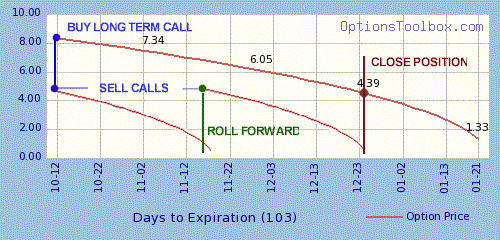Spreads | ||
Spreads are the most versatile option strategy, there are practically as many spread combinations as there are trading objectives. A spread consists of two legs, both are either calls or both are puts, one is short and one is long. A good spread consists of selling an option that has a high volatility and covering the risk by buying a similar option with lower volatility. This can be done with options with different strike prices that expire in the same month (vertical spread), or options that have different expirations but the same strike (horizontal spread), or any combination of the two (diagonal spread). Option months were originally listed on the board at the exchange from left to right. At the same time, strike prices were listed from top to bottom. For this reason, options with different strike prices and the same expiration are often referred to as vertical spreads. Options with the same strike price and different expirations are often referred to as horizontal spreads.
Vertical SpreadsA vertical spread consists of two option legs where each leg has the same expiration but a different strike. Two common objectives of trading spreads are to reduce the cost of buying single options or limit losses of a long or short position. Spread strategies can be characterized as bullish or bearish depending on whether the spread will realize the greatest profit if the stock moves up or down. The Bull Call Spread and the Bear Put Spread both involve buying a near the money call or put, and selling an out of the money option to offset the cost of the trade. The total risk is the initial cost of the position, and the maximum gain is the difference between the strike prices (the spread) minus the cost of the trade. Bull Call Spreads and the Bear Put Spreads are net debit positions, that is, money is taken out of the trader's account when the trade is made.
The Bull Put Spread and the Bear Call Spread both involve selling an in the money option. The position will profit if the in the money option declines in value. An an out of the money option is purchased to limit the risk of loss if the short option gains in value. The total risk is is the difference between the strike prices (the spread) minus the cost of the trade and the maximum gain is the amount collected from the the initial trade. Bull Put Spreads and the Bear Call Spreads are net credit trades; the trader will receive cash upon entering the transaction.
Horizontal SpreadsThe terms Horizontal Spreads, Time Spreads, and Calendar Spreads describe the same type of trade. The rate of time decay increases as the option's expiration date approaches. As a result, the amount of premium lost on short term options is greater than the amount lost over the same period of time for a longer term option. A Calendar Spread consists of two legs, the long leg is a long term option and the short leg is the short term option. (long the long, short the short). The objective of the calendar spread is to collect the short term premium while protecting against loss with the purchase of a long term option at the same strike. When the short term option expires, the position can be rolled forward into another short term option with the same strike. The process is repeated, and the sum of the premiums collected from the short sales should exceed the premium spent on the long term call.
In simplest terms, a long calendar spread involves buying an option with a longer expiration and selling an option with the same strike price and a shorter expiration. For example, the DIAMONDS are selling at $103. The 1 month, 2 month, and 3 month at the money options are trading at 1.15, 1.95, and 2.60. The calendar spread trader would sell the 1 month option for 1.15 and buy the 3 month option for $2.60. Assuming the price is stable at the end of 1 month, the 1 month option would be worthless and the long option, which is now a 2 month option, would be worth $1.95. The trader would gain 1.15 from the sale of the short leg and lose .65 on the long leg, with a net profit of .50. The trader could opt to sell another near term option or simply sell the long call to close the position. Calendar spreads are profitable when the underlying stock price remains stable. Therefore, the strategy is essentially neutral. A large swing in either direction in the underlying stock price will result in a diminished time premium and potentially cause the position to lose value. Horizontal spreads are also used to roll straddles forward when a straddle leg moves into the money.
|


